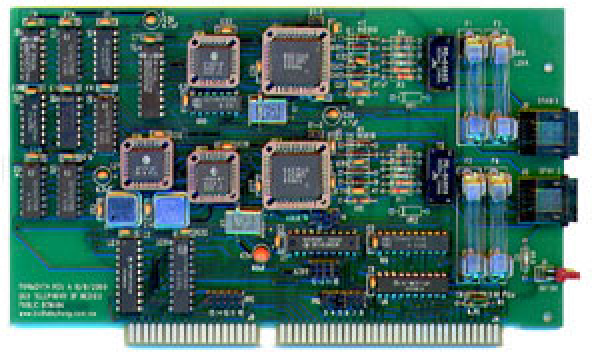SS7 for the
Common Man
Last modified: Sun, 05 Mar 2006 08:34:25 GMT
| Home |
| ||
| ||
| ||
| ||
| ||
Tormenta Interface Card
Description: OpenSS7 Hardware Selection Tormenta
The Tormenta card is a 2-T1 port ISA card manufactured by Zapata Telephony. These firgure below shows a picture of a Tormenta card.
The Tormenta cards ahve the lowest level of signalling performance due to the ISA bus and the lack of on-board HDLC functions. Transfers to the host processor over the ISA bus use I/O port and ISA DMA transfers.
Driver
OpenSS7 does not support a driver for this card. See the Status page for this card for more information.
Although it is possible to convert the OpenSS7 drivers to work with this ISA card, it would be rather pointless as their are better PCI cards available.
Features
Following are some features of the Tormenta card:
- 2 T1 spans per card.
- DMA transfer of octets from framers to ISA bus.
- Uses OpenSS7 Soft-HDLC engine for SS7, ISDN and ISO.
- 48 channels per card.
Advantages
Following are the advantages of the Tormenta card:
- Low cost.
- PC Compatibility.
- Released by Jim Dixon under the GNU Public License.
- Open Hardware design: schematics, artwork and Gerber plots available.
- Supports a number of Open Source drivers.
- Zaptel driver support.
Disadvantages
Following are the disadvantages of the Tormenta card:
- Lowest performance.
- No on-board HLDC.
- Cannot TDM switch on card or between cards, media channels must be transferred through host to switch between cards.
- ISA I/O Port with DMA support but no memory mapping or burst transfers.
- ISA bus.
- No integrated Ethernet for SIGTRAN and VoIP applications.
- Synchronization per-card instead of per-system.
Ultimately, the performance limited factor of the Tormenta cards is the bandwidth of the ISA bus and the ability of the processor to perform Soft-HDLC and TDM switching in software. A 350MHz processor is capable of handling the bandwidth ofseveral of these cards, however, the ISA bus is not capable of more than one card.
For the OpenSS7 VoIP Switch, this performance is dismal. This is why a driver has not been writtenfor this card.
Disclaimer
 Note:
Some of the information in this hardware selection guide may be incomplete, incorrect, out of
date, or inconsistent with the vendor's actual offerings.
Also note that this hardware selection guide does not constitute an endorsement of anyone's
product or service. The authors of the OpenSS7, their sponsors, agents and representatives will
not take responsibility in it.
Note:
Some of the information in this hardware selection guide may be incomplete, incorrect, out of
date, or inconsistent with the vendor's actual offerings.
Also note that this hardware selection guide does not constitute an endorsement of anyone's
product or service. The authors of the OpenSS7, their sponsors, agents and representatives will
not take responsibility in it.
Please use good business sense when considering any vendor's products and consult with the individual vendor before making any decisions. Please do, however, investigate the product and service offerings of the sponsors listed on our Sponsors page: it is through your support of our sponsors that the OpenSS7 Project exists and is funded to continue.
SS7 for the
Common Man
| Home |
© Copyright 1997-2007 OpenSS7 Corporation All Rights Reserved.
